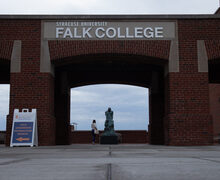Praise the roof: Admissions building’s green design receives award for natural environment, functionality
Natalie Riess | Art Director
The arrival of spring often leads to a focus on freshly planted flowers and blooming plants, but for SUNY-ESF it has led to recognition for one of its buildings on campus.
The State University of New York College of Environmental Science and Forestry and an architecture firm received a merit award from the New York chapter of the American Society of Landscape Architects for the Gateway Center’s green roof.
The ASLA presented the honor at its award ceremony and reception on April 3 at the Center for Architecture in New York City.
Andropogon Associates of Philadelphia, a landscape architecture and ecological design firm, designed the Gateway Center’s green roof. It was funded with a Green Innovation Grant of $413,000 from the New York State Environmental Facilities Corp., according to a Mar. 27 press release.
Building and design awards are positive for SUNY-ESF because they show commitment to excellence, said Tim Toland, a landscape architecture associate professor, in an email.
“As a researcher, this award means that we are on the right track with this idea,” he added.
The green roof can enhance the experience of students, faculty, staff and visitors to campus, Toland said. He said SUNY-ESF prides itself on innovative design because the students and faculty take ideas from the classrooms and use them in the real world.
“The idea of practicing what we teach is very strong here,” he said. “This award reinforces that approach.”
The roof currently has a large deck component that is used by the campus community year round, Toland said. It is also open and accessible when the building is open so that people can eat, study and socialize on it.
The roof is also located right outside of the Gateway Center, SUNY-ESF’s admissions office, so prospective students and families can see what the university is all about, he said.
Toland added that the plants used on the roof are considered marginal plant communities because they are characterized by extreme growing conditions, based on a combination of soil, water and climatic conditions.
Andropogon Associates, the architecture firm that designed the green roof, chose to use plants such as Eastern sandcherry, Sand dune willow, American beachgrass, Field wormwood, Wavy hair-grass and Canada wildrye, said Darren Damone, an architect at Andropogon Associates.
“We chose those plants because conditions are harsh,” he said. “The type of soil is not like the soil on the ground. It’s lightweight and drains quickly.”
Damone said he and his associates also worked with faculty at SUNY-ESF including Tim Toland and Don Leopold, an environmental forest biology professor, in order to determine the best plants for the roof.
“As our firm was going through the process, we consulted with them and found a plant community that was native to Upstate New York,” Damone said.
He said the firm chose those plant communities because the roof reflects the natural conditions that the plants are used to in Upstate New York, such as drought and flooding. The firm conducted an 18-month study on the plants to ensure that they would survive on the roof, he added.
The aesthetic aspects of the roof are due to a combination of things, Damone said. The design was also based on how well the plants would flow with the deck type and roof edge, he said.
Damone said that the firm also used wooden materials because it drew inspiration from local plant communities and wood is common to coastal communities like Lake Ontario.
For Andropogon Associates, the award means that they can design something that is both aesthetically pleasing and highly functional, Damone said.
“You can have a beautiful space that’s aesthetic but it also serves a function of research and learning,” he said.
SUNY-ESF will continue to monitor the green roof for at least two more years, Toland said, by looking at plant survivorship and growth dynamics, as well as water quality.
Toland said he and Leopold hope that they will have enough data to convince others of the viability of these plants at the end of the monitoring period.
Published on April 7, 2014 at 1:02 am




